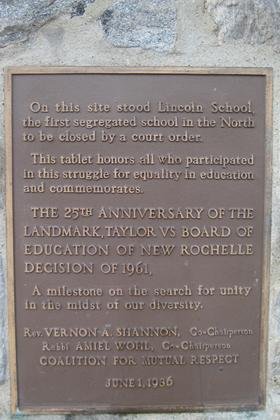A Basketball Court and a Ghost Railway
WHERE: New Rochelle and Pelham, New York
START: New Rochelle station (Metro North Railroad, New Haven Line, and Amtrak), fully accessible
FINISH: Pelham station (Metro North Railroad, New Haven Line), accessible at the eastbound (outbound) platform
DISTANCE: 2.0 miles (3.2 kilometers)
Photographs by Michael Cairl except as noted. Map courtesy footpathmap.com
Route of this walk, reading from right to left.
I’ve recently met an abstract artist, Scott Albrecht, whose work I like a lot. Scott is also a very kind and intelligent soul. He designed the surface of a basketball court in a city park in New Rochelle, just north of New York City. I was determined to have a look for myself and combined that with a visit to one of the few remaining vestiges of the New York, Westchester and Boston Railway north of the Bronx. The route was fairly hilly, making for a decent workout on a crisp late November day.
The walk started at the New Rochelle station of Metro North and Amtrak. From the station house at the westbound (inbound) platform I walked up the ramp to North Avenue and turned left. There was a fully accessible detour around where North Avenue crosses the New England Thruway (Interstate 95) owing to the rebuilding of the North Avenue crossing. I continued a few blocks up North Avenue, through a tired-looking commercial strip, then crossed and turned left on Lincoln Avenue. A few blocks on, I crossed Malcolm X Way then crossed to the opposite (south) side of Lincoln Avenue and turned right. At this point Lincoln Avenue is on a steep-but-not-too-steep hill, and on the left was my first stop, Lincoln Park.
Lincoln Park is on the site of Lincoln School, a segregated public school that was closed by court order in 1961 and subsequently razed. This history is memorialized on a plaque on Lincoln Avenue near the corner of Prince Street.
Just inside the park was the basketball court I was looking for. This was completed in 2018 in partnership with Project Backboard and the National Basketball Players Association. Seeing an aerial view, I had to see it at ground level. I was not disappointed.
Image courtesy Google Earth. Lincoln Avenue is at the bottom.
For all the life and activity there is on a basketball court, it can be a pretty humdrum place, just a rectangle of asphalt. The Lincoln Park court is something special, a gift to a diverse community that might have been overlooked. Perhaps this can be viewed as a mural put not on a wall but on an athletic surface. Scott Albrecht’s horizontal mural fills its space differently than the usual vertical mural would, leading to a different interaction. The patterns on the court could be seen as mimicking how a player maneuvers in a basketball game. It is not representational art. It’s not what’s there; it is what we see. This place allows one to see and imagine many things while shooting hoops or, as I did, just looking on. I’m glad I came here, for it is a special place.
Leaving the park, I continued uphill (west) on Lincoln Avenue through a tidy neighborhood. The sidewalks were in good condition and most of the curb cuts were. At the boundary between the City of New Rochelle and the Village of Pelham (pronounced pell-um) I saw this.
A short distance on I turned left onto Highbrook Avenue, stumbling but not falling as I did so. Suffice it to say that the sidewalks in leafy Pelham could benefit from some attention. Ahead of me was the Highbrook viaduct, built by the New York, Westchester and Boston Railway.
I’ve written about the “Westchester” after several previous walks in the Bronx. This state-of-the-art (for 1912) commuter railroad was a spectacular failure, built by the New York, New Haven and Hartford Railroad and essentially competing with the New Haven. After service on the “Westchester” ended on the last day of 1937, little effort was spared to eradicate it from the landscape, especially in Westchester County. It seems strange, then, that this substantial structure was left standing. Just west of here was the railroad’s Mount Vernon Junction, from which two tracks went north to White Plains and two went east to New Rochelle (later to Port Chester). The Highbrook viaduct is on what was the Port Chester branch. Part of the right-of-way east and west of the viaduct is now preserved as a park. Just past the viaduct is this historical marker.
Just past this marker I turned onto Harmon Avenue in the direction of the Pelham station. Harmon Avenue has many fine old houses, one of which, number 65, really caught my eye.
Lunch was at a nice neighborhood restaurant across from the Pelham station called The Rail House.
This was a good, enjoyable walk with the benefit of public art along the way. Thanks to Scott Albrecht for creating the work that got me up there. There is so much to see if we just open our eyes and minds.








